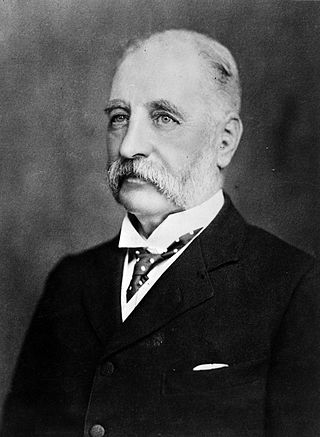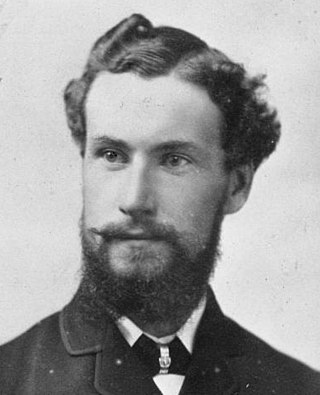
Sir James Hector was a Scottish-New Zealand geologist, naturalist, and surgeon who accompanied the Palliser Expedition as a surgeon and geologist. He went on to have a lengthy career as a government employed man of science in New Zealand, and during this period he dominated the colony's scientific institutions in a way that no single man has since.

Standard time is the synchronization of clocks within a geographical region to a single time standard, rather than a local mean time standard. Generally, standard time agrees with the local mean time at some meridian that passes through the region, often near the centre of the region. Historically, standard time was established during the 19th century to aid weather forecasting and train travel. Applied globally in the 20th century, the geographical regions became time zones. The standard time in each time zone has come to be defined as an offset from Universal Time. A further offset is applied for part of the year in regions with daylight saving time.

A time ball or timeball is a time-signalling device. It consists of a large, painted wooden or metal ball that is dropped at a predetermined time, principally to enable navigators aboard ships offshore to verify the setting of their marine chronometers. Accurate timekeeping is essential to the determination of longitude at sea.

George Vernon Hudson FRSNZ was a British-born New Zealand entomologist credited with proposing the modern daylight saving time. He was awarded the Hector Memorial Medal in 1923.

Wellington East Girls' College is a state single-sex girls' secondary school which sits directly above Mount Victoria Tunnel, Wellington, New Zealand. Serving Years 9 to 13, the school currently has 1072 students.

Kelburn is a central suburb of Wellington, the capital city of New Zealand, situated within 1 kilometre (0.62 mi) of the central business district.

The Tararua Range, often referred to as the Tararua Ranges or Tararua, is one of several mountain ranges in the North Island of New Zealand.

Mount Hikurangi is a 1,752 m (5,748 ft) peak in the eastern corner of New Zealand's North Island, about 80 kilometres (50 mi) north of Gisborne, and 50 kilometres (31 mi) southwest of the East Cape Lighthouse. On a spur of the Raukumara Range in the Waiapu Valley, it is the North Island's highest non-volcanic peak.

Space Place at Carter Observatory is an observatory in Wellington, New Zealand, located at the top of the Wellington Botanic Garden.

Conservation in New Zealand has a history associated with both Māori and Europeans. Both groups of people caused a loss of species and both altered their behaviour to a degree after realising their effect on indigenous flora and fauna.

The Thomas King Observatory stands at the top of the Botanic Garden in Wellington, New Zealand, as part of the Carter Observatory. In the past it has housed research, preservation of heritage, education and promotion of astronomy to the public.

Māui dolphin, Maui's dolphin, or popoto is a subspecies of the Hector's dolphin —New Zealand's only endemic cetacean. Māui dolphins are only found off the west coast of New Zealand's North Island, and are now one of the rarest and smallest dolphin subspecies globally. A 2021 report issued by the New Zealand government suggests the population rests at 54 individuals, but when taking into account recent mortalities, the population could sit at fewer than 50 individuals. Both the Māui dolphin and South Island Hector's dolphin are threatened by commercial fisheries, including set-netting and trawling, recreational netting, and disease including toxoplasmosis and brucellosis. Low food availability may also be an issue for Māui dolphins, which may increase their susceptibility to climate change.

John Campbell was a New Zealand architect, responsible for many government buildings in New Zealand, among them the Dunedin Law Courts, the Public Trust Building in Wellington, and Parliament House. From 1909 until his retirement in 1922 he held the position of government architect.
Robert Cecil Hayes was a New Zealand astronomer, seismologist and organist. He was born in Wellington, New Zealand on 19 January 1900.

Evans Bay is a large bay at the southern end of Wellington Harbour, New Zealand. Located between the Miramar Peninsula and Hataitai, it was the site of New Zealand's first patent slip and served as Wellington's international flying-boat terminal from 1938 until 1956. It is named after George Samuel Evans, an early Wellington settler.

Aorangi Forest Park is a 194-square-kilometre (75 sq mi) protected area in the Wellington Region of New Zealand administered by the Department of Conservation (DOC). It had been called the Haurangi Forest Park but DOC changed to reflect the Māori name of the range protected by the park.

The Carkeek Observatory is the earliest surviving astronomical observatory in New Zealand. It was built around 1867 by retired customs officer and amateur astronomer Stephen Carkeek on his farm south of Featherston in the Wairarapa. The timber building was in two parts: an octagonal room with a rotating canvas dome, and a rectangular annex. Carkeek died in 1878 and the disused observatory became a farm equipment shed. As late as the 1980s it was still largely intact, but is now a partial ruin, although the annex and parts of the rotation mechanism can still be seen in place. It was added as a Category I historic place in the New Zealand Heritage List on 26 June 2020.

Stephen James Carkeek was a New Zealand civil servant, the colony's first Inspector of Customs, and the builder of the oldest-surviving observatory in the country.

Whitireia Park is a headland north of Titahi Bay and Te Awarua-o-Porirua Harbour in Porirua, in the Wellington Region at the southern end of New Zealand's North Island. It is a regional park administered by Wellington Regional Council.
John Tenison Salmon was a New Zealand photographer, entomologist, academic, conservationist, and author. His primary occupation was as an entomologist; first at the Dominion Museum and then at Victoria University College.



















